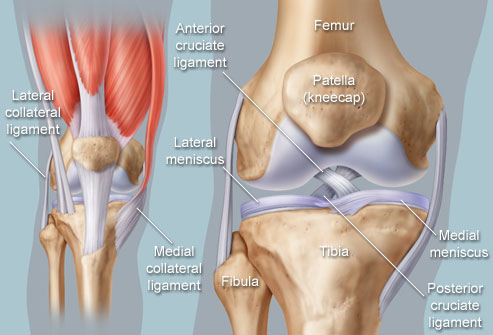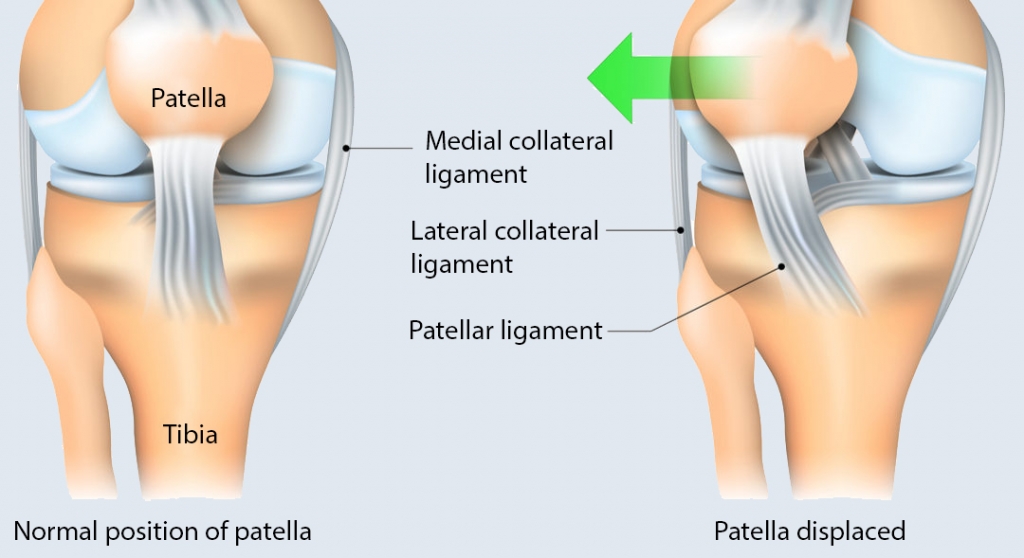Patellar (kneecap) dislocation
Function and location of the kneecap
The knee or knee joint (articulatio genus) connects the leg to the thigh. The knee joint is the largest, most complex and at the same time the most vulnerable joint in our body. When walking, half of the body’s weight weighs on it, and when taking the stairs, 2-3 times of the body’s weight. The role of the knee joint is to create a load transfer between the tibia and femur so that there is controlled yet free movement. The patella plays a crucial role in the transferring of stress to the quadriceps.

The back surface of the kneecap is covered with a layer of hyaline cartilage, it mainly moves up and down during bending. This movement is basically completely painless, soundless. If the cartilage surface behind the patella is damaged, the most common complaint is pain of the bent knee during long period of sitting.
One of the most sensitive and vulnerable parts of the knee joint is the area around the patella, also called the patellofemoral joint. Both painful and unstable conditions can develop, mainly due to the dislocation of the patella. Knee injuries due to increased load are also most common in the front of the knee, around the patella.
Kneecap dislocaiton
Normally, the kneecap fits exactly into the trough on the anterior surface of the femur, therefore both sides are loaded equally. If the shape of the patella or femur is different, an uneven load will develop, which can quickly lead to cartilage damage.
The kneecap is held laterally by strong ligaments in the centreline. Abnormal anatomical position or insufficient ligaments can cause the patella to move relative to the midline. This most often happens in lateral (outward) direction, as the bony edge of the femur is lower here.

Types of kneecap dislocation
Bone fractures and sprains are the most common injuries of the patella.
Both are associated with damage to cartilage surfaces, which is why their treatment requires more care. In the event of a fracture, the most accurate fit possible should be sought. Even in the case of a sprain, damage to the articular surfaces is the main problem.
There may also be a habitual patella luxation (slip) when the kneecap can leave its place sideways several times a day. In this rare case, some acquired or congenital deformity of the joint or axial deviation of the knee joint (high degree of overhanging, X-leg) causes the problem. In this case, severe destruction of the cartilage surfaces occurs.
What are the symptoms of kneecap dislocation?
The leading symptom of the problem is pain in the front of the knee, behind the patella, which occurs mainly when it is strongly bent:
- when walking down the stairs,
- when squatting,
- when walking on uneven ground,
- while running.
It is also a characteristic symptom when long period of sitting causes knee pain as the kneecap is strongly pressed into the articular cavity when bent, which can provoke pain.
How is kneecap dislocation diagnosed?
Kneecap dislocation is easily diagnosed because it is visible to the naked eye when its position differs from the centreline of the femur.
Which surgical procedure can be used to cure patellar dislocation?
Treating the cartilage surface of the patella is not an easy task, as the space for proven cartilage rescue interventions is very tight. It further complicating the procedure that the bone thickness under the cartilage is very thin (the patella is about 2 cm thick).
The method often used in our hospital is “lateral release”, in which the knee specialist orthopaedist cuts the ligament holding the kneecap from the outside, thus eliminating the force pulling the kneecap outwards and allowing the bone to move freely, thus reducing the pressure on the cartilage surface. This results in lighter, more complaint-free knee movements.
Surgery can be performed with open procedure as well as with arthroscopic intervention. The goal is to completely cut through the fibres of the ligament. The intervention has no significant complications.
